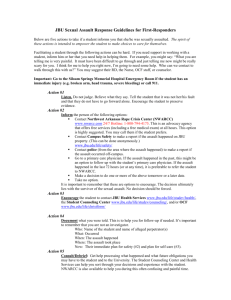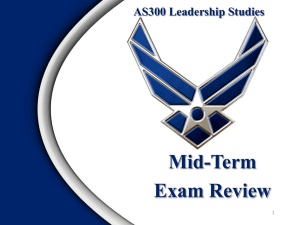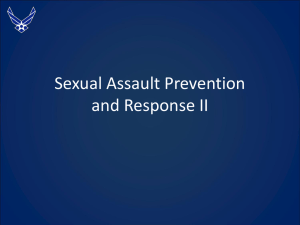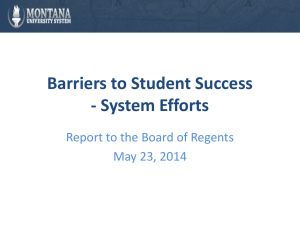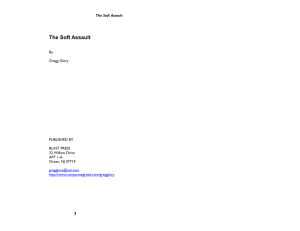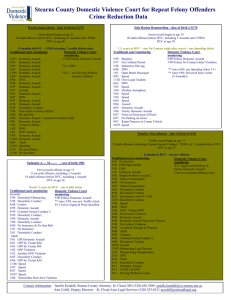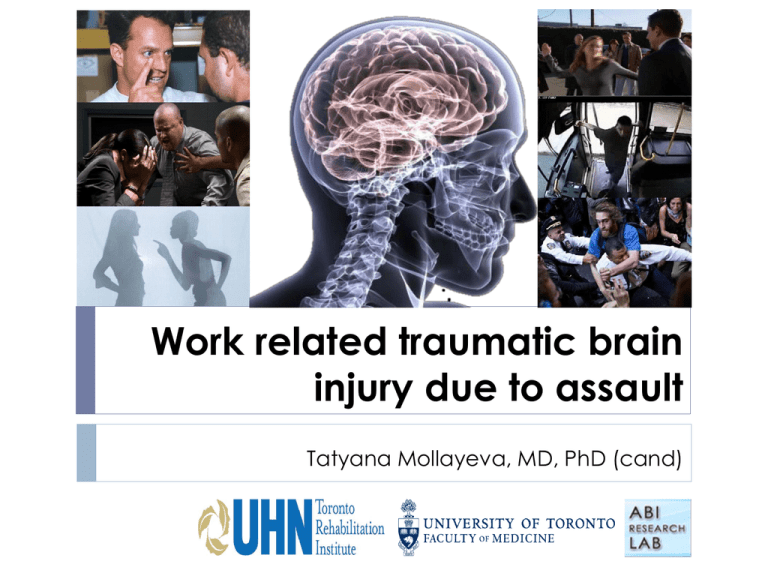
Work related traumatic brain
injury due to assault
Tatyana Mollayeva, MD, PhD (cand)
Co-authors and funding
Co-authors:
Shirin Mollayeva, BSc (cand), John Lewko, PhD,
Angela Colantonio, PhD
Funding:
Disclosure
The authors have no conflict of interest to disclose
Traumatic brain injury: definition
“an alteration in brain
function, or other evidence of
brain pathology, caused by
an external force”1
1Brain
Injury Association of America. About Brain Injury. 2011. Retrieved June 10, 2012, from http://www.biausa.org/about-brain-injury.htm.
Background
1.
2.
3.
4.
5.
≈628,000 Canadians live w/ brain injury-related disability1
Over 50% are under 20 years of age1
Most traumatic brain injury (TBI) causes preventable (e.g. falls,
motor vehicle accidents, assaults)
TBIs at work (wrTBI) may differ in patterns and risks from injuries
outside the workplace2,3
wrTBIs, 1993-2001: 3.6% assault-related, likely underestimate4
Occupational Health and Safety Act wrt workplace violence5 assault at work a broad public health concern
Physical and psychological effects severe, assoc. with great
financial loss6
NHCC and BIAC Election messaging. (2011, 3 29). Retrieved 04 04, 2014, from Brain injury Association of Canada: http://biac-aclc.ca/2011/03/29/nhcc-and-biac-electionmessaging/.
Workplace Safety and Insurance Board’s (WSIB) 2005 Annual Report. Retrieved 01 01,2014, from
http://www.wsib.on.ca/files/Content/Downloadable%20File2005StatisticalSupplement/2278A_StatSup.pdf
Colantonio A, Mroczek D, Patel J, Lewko J, Fergenbaum J, Brison R. Examining occupational traumatic brain injury in Ontario. Can J Pub Health. 2010; 101: S58-62.
Kim H, Colantonio A, Chipman M. Traumatic brain injury occuring at work. Neurorehabil, 2006; 21: 269-278.
Canadian Centre for Occupational Health and Safety Act. Retrieved 4 11, 2013, from http://www.gov.pe.ca/law/statutes/pdf/o-01_01.pdf.
Gap in knowledge and study objectives
Despite evidence for risks of work-related assault, data on wrTBI
due to assault in Canada is lacking
Objectives:
Assess extent of assault resulting in TBI by sex, across
occupational sectors in Ontario
Examine related demographic and workplace
characteristics
Provide better understanding of circumstances of incidents
Data collection
Case series design, examined all claims with 2004 injury date
and categorized as “intracranial injury” or “concussion”, also
examined “traumatic” fatalities
1,006 files met criteria, positive identification of TBI; accepted
only with confirmed diagnosis by physician of “concussion”,
“closed head injury”, “contusion”, “head injury with
sequelae consistent with brain injury”1
Qualitative and qualitative data analyses
1. Colantonio A, Mrockzek D, Patel J, Lewko J, Fergenbaum J, Brison R. Examining occupational traumatic brain injury. Can J of Public
Health. 2010; 101(2): S58-62.
Variables
Socio-demographic (i.e. sex, age, occupation type/sector,
years employed)
Injury-related (i.e. mechanism of injury, shift worked, date/time
of injury, day of week)
Event summaries to categorize cases by type and source of
aggression
Data analysis
Frequency distributions, central dispersion for demographic
and injury variables
Denominator: Statistics Canada 2004 data on employment, by
sex1
Case categorization:2
Type 1: external/intrusive violence (assailants have no
relationship to workplace)
Type 2: consumer/client related offence (related to
interaction w/ customer/patient/student)
Type 3: relationship violence (assailant a co-worker or
partner)
Type 4: organizational violence (assault premeditated,
carried out by coordinated force/group of people)
1.
2.
Government of Canada. Economic Data Tables. Retrieved 3 11, 2013, from Statistics Canada: Employment by age, sex, type of
work, class of worker and province (monthly): http://www.statcan.gc.ca/tables-tableaux/sum-som/l01/cst01/labr66g-eng.htm.
Bowie V. Workplace Violence. New South Wales: Work Cover; 2002.
Results
Demographic characteristics
wrTBI claims (n), by cause
66
1006
injury due to
physical assault
injury not due to
physical assault
Age range=20-64 (median 37 y.o.)
≈assault-related wrTBI claim
rate=9.85/1 million Ontario
employees
Claim rate for women≈11.79/1 mil
Ontario workers; men≈8.4/1 mil
wrTBI (n) due to assault, by sex
Female
27
39
Male
Frequency of wrTBI caused by
physical assault greater in female
employees (59.1%), higher than
that for all TBI cases of all
mechanisms (42.3%)
Demographic characteristics
Physical assault-related wrTBIs (n), by occupation
other (mostly
drivers), 8
education
sector, 10
police/guards/
security/law
enforcement/
public
administration
personnel, 22
health care
aides, 27
Sex differences within sectors
Health care/social services sector:
Rate of wrTBI six-fold higher for female
workers
Education sector:
Rate of wrTBI four-fold higher for female
workers
Police/guard/law enforcement sector:
Rate of wrTBI 13-fold higher for male
workers
Work experience
wrTBI, by years employed
>20 yrs
6%
NR
4%
<3 yrs
46%
>10 yrs
23%
43% employed <1
year
4-9 yrs
21%
Temporal characteristics
Highest number of TBIs due to assault
in 2004 occurred in March and
November
Weekly peaks – Mondays and Fridays
Most injuries occurred in late morning
and early afternoon
Event-related characteristics
Types 3/4
(relationship/org
anizational)
8%
Type 2
(consumer/client
-related)
71%
Images: Yow Canada Inc.
Assault types
Type 1
(external/instrusiv
e)
21%
Event-related characteristics
>40% of assaults resulting in wrTBI occurred in one-on-one
interactions with clients; >1/3 - dealing with irate/angry
clients
23% - attempts to restrain/follow suspicious individuals
12% - dealing with disabled/special needs individuals or
those with awareness issues
7% - in mobile workplaces (i.e. taxi, bus, etc.)
Sex differences: additional injuries to other body parts
(e.g. neck, arms, etc.) – more in women (79%)
Cost of claims
Return to work
by end of data
collection
23%
10 female and 5 male
workers
No return to
work before
data
collection
completion
77%
75% off work for >2 months
Total days of disability=8,953
Women accrued more disability
days compared to men (5,166
vs. 3,787)
Limitations
Estimates yielded conservative as approximately 70% of
Ontario workers are insured by WSIB
Remaining 30% may not have similar characteristics
wrTBI due to assault examined for a period of one year
only; a longer period of time is needed to understand the
full scope of the mechanism of wrTBI
Implications for prevention
Workers with less experience (i.e. <3 years employed)
overrepresented: training promoting awareness of
workplace assault, testing on ability to identifying risks prior
to release to independent duty.
Working with persons with cognitive and/or mental health
challenges: conflict management, empathy, training to
predict and react to aggression
One-on-one with client: self-defense, working in pairs
Guarding property, following suspect: restraint and selfdefense training
Mobile workplace: training to recognize potentially
threatening situations, client awareness of zero tolerance
policy for aggression and assault toward workers
Conclusions
First paper examining wrTBI
due to assault; representative
sample of workers; focus on
sex
wrTBI due to assault across
industries and types of
physical aggression
Results can serve as a basis for
further wrTBI surveillance work;
stimulate development of
appropriate control efforts in
work-related assault
Thank you!


